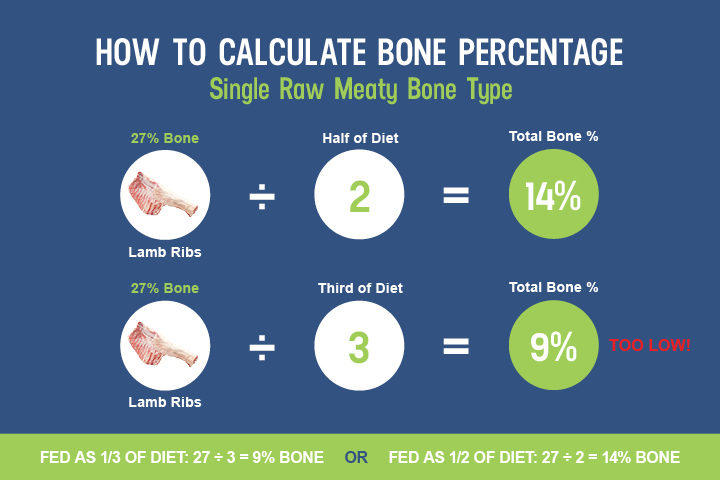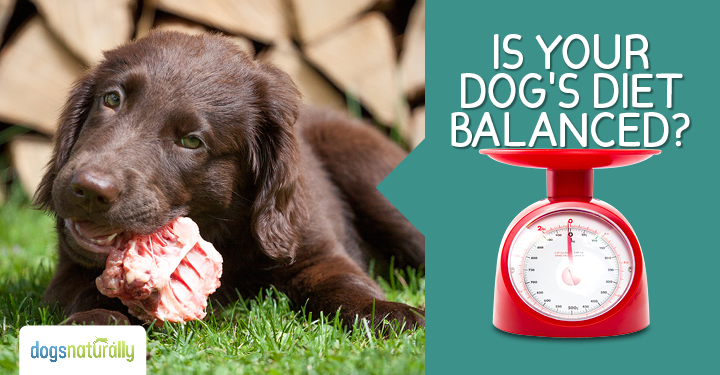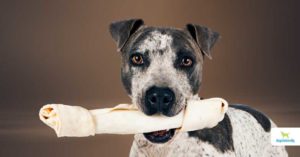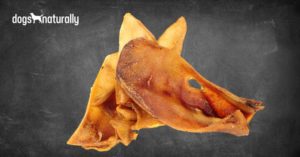Do you sometimes feel like you need a nutrition degree to feed your dog a raw diet?
One of the things that stops people from feeding a raw diet for dogs … is the notion that creating and balancing a diet is an exact science. They worry that it must be done in a laboratory.
This couldn’t further from the truth!
So if you’ve been reluctant to switch to a raw diet because you’re worried …
… read on, because it’s easier than you think!
There are a few guidelines you need to follow to get the right balance of vitamin and mineral content … but you can do it. The most important one is balancing the minerals calcium and phosphorus in your dog’s diet.
Phosphorus
Meat is very high in phosphorus and low in calcium. The main function of phosphorus is in forming bones and teeth.
It plays an important role in the body’s use of carbohydrates and fat.
Phosphorous also helps the body with:
- Synthesizing protein for growth, maintenance and repair of cells and tissues
- The production of ATP, a molecule the body uses to store energy
- Supporting B vitamins
- Muscle contraction
- Kidney function
- Heartbeat regularity
- And nerve conduction
Calcium
Bone is high in calcium and in phosphorus.
According to Dr Ian Billinghurst (author of Give Your Dog a Bone and other well known books on canine nutrition) … calcium’s role goes far beyond bone mineralization.
“Calcium is essential for neuromuscular, cardiovascular, immune and endocrine function. It’s vital for blood clotting. Calcium forms the skeletal structure or cytoskeleton within each cell. And every cell in the body depends on calcium to support enzyme functions, bodily signalling and to maintain cell membrane stability.”
Related: How To Give Your Dog Vitamins
It’s A Balancing Act
Dogs need a balance between the amount of phosphorus and calcium they get in their daily diets.
The ratio of calcium to phosphorus should be about 1:1 … but preferably with slightly more calcium than phosphorus.
This is especially important in young, growing dogs. They need an adequate supply of raw meaty bones (RMBs) in their diet. RMBs provide a good balance of calcium and phosphorus. We’ll talk more about this later.
Feeding good organic muscle meats is really important. But you need to also know … an all-meat raw diet isn’t enough. It will be too high in phosphorus and low in calcium. This is unsuitable for young pups and can cause skeletal problems.
Calcium deficiency can also cause skeletal demineralization, particularly of the pelvis and vertebrae.
Excess calcium can also interfere with normal healthy bone mineralization and growth. This is especially true in young (under 1 year-old) large and giant breed dogs.
Large breeds fed excess calcium are more likely to suffer from developmental bone disease … such as osteochondrosis (abnormal bone growth).
Balancing The Calcium: Phosphorus Ratio
It might seem daunting to calculate the calcium: phosphorus ratio in a home prepared raw diet. The good news is it’s really not that complicated.
Dr Billinghurst explains:
“Approximate biological balance is achieved so long as meat alone is not the principal dietary component. That job must be left to the raw meaty bones (RMBs). When a young and growing dog eats RMBs, if the bone to meat ratio of those RMBs is around 1:1, then the balance of calcium to phosphorus is appropriate for bone mineralization and formation.”
Dr Billinghurst also says that adult dogs need less calcium. So as long as you’re feeding a raw diet with raw meaty bones, the adult dog’s body will absorb the calcium it needs. If there is any excess it will leave what it doesn’t need in the intestines.
Overall, balancing calcium and phosphorus isn’t all that difficult. Your dog just needs to eat raw meaty bones.
In general, any bone content over 10% is plenty … although you shouldn’t exceed 25% because dogs need other nutrients too.
RELATED: How to balance calcium in your dog’s homemade diet …
Bone Content In Raw Foods
When sourcing bones for your dog’s diet, it’s important to know the approximate amount of bone in foods. Here is a quick guide to help you keep your dog’s bone content in the right range: between 10 and 25%.
The information is mainly from the US Department of Agriculture’s (USDA) National Nutrient Database.
Chicken
- Whole chicken (not including the head and feet): 25%
- Leg quarter: 30%
- Split breast: 20%
- Thigh: 15%
- Drumstick: 30%
- Wing: 45%
- Neck: 36%
- Back: 45%
- Feet: 60%
- Head: 75%
Turkey
- Whole turkey: 21%
- Thigh: 21%
- Drumstick: 20%
- Wing: 37%
- Neck: 42%
- Back: 41%
Duck
- Whole: 28%
- Neck: 50%
- Feet: 60%
Pork
- Feet: 30%
- Tails: 30%
- Ribs: 30%
- Country style ribs: 21%
Beef
- Ribs: 52%
- Oxtails: 45% to 65% (the percentage goes up as the tail gets thinner and less meaty)
Rabbit
- Whole rabbit (fur and all): 10%
- Whole (dressed): 28%
Lamb
- Rib: 27%
- Shoulder blade: 24%
- Whole shoulder (arm and blade): 21%
Game birds
- Quail: 10%
- Guinea hen: 17%
- Squab (pigeon): 23%
- Wild duck: 38%
- Pheasant: 14%
- Cornish game hen: 39%
Pulling It All Together
Balancing calcium and phosphorus is quite easy … and much easier with this guide!
To make sure your dog’s diet includes between 10% and 25% bone, feed your dog 25% to 60% raw meaty bones (RMBs) like the ones above.

Let’s get started with a bit of simple math …
You pick up some great looking lamb ribs at the butcher. You know those lamb ribs are 27% bone.
So you fed your dog a pound of boneless meat and organ meats for breakfast. Then you fed him a pound of lamb ribs for dinner. This would mean he would have eaten 14% bone.
Here’s the arithmetic.
He ate two pounds of food, half of which was lamb ribs, which are 27% bone. Half of 27% is 13.5% … but we don’t need to get down to decimals, so round up and call it 14% bone in his diet for that day.
Here’s another example.
Let’s say you have a 60 lb dog. Normally you’d feed 2% to 3% of his body weight in raw food. So, using 2.5%, your dog would eat about 1.5 lbs (or 24 oz) of food per day.
So let’s say you fed him 0.5 lb lamb ribs and 1 lb meat and organ meats. You’d divide the amount of bone by 3, because a third of his food for that day is lamb ribs.
You’ll see your dog is getting 9% bone. Not enough!
So let’s try increasing it to 40% lamb ribs, which would be about 10 oz. Now, 40% isn’t quite as easy to calculate as a third or a half. So in this case it’s easier to just take 40% of 27% (multiply 27 by 0.4) and you’ll see your dog would be eating nearly 11% bone. Not bad!
So now you know how much bone to feed your dog. All that you need to do now is include 15% organ meat and round out the rest of his diet with nice boneless meats.
Told you it was easy!
Here Are A Couple More Tips
- The bone content values in this list are approximate. However, that’s really all you need to provide your dog with a safe and healthy raw diet.
- Avoid grocery store meats as they are often treated with bleach or enhanced with salt.
- Make sure you feed bones that are appropriate for the size of your dog. Avoid pieces that could be a choking hazard. (If you’re still worried about choking or cracked teeth, try a bone powder instead.)
So let your worries go! If your dog gets biologically appropriate raw foods … he isn’t likely to have a nutritional health problem. In fact, your dog will likely have more energy and improved health on his raw diet!













